Two cousins trek to a remote island mountain in B.C. for the shortest ski of their lives.
Haida Gwaii, formerly known as the Queen Charlotte Islands, is an archipelago off the northern coast of British Columbia. It’s home to the Haida people, a First Nations group known for their carving and canoe building skills. The main industries are tourism, logging, and fishing. There are also mountains there, mountains that catch a legendary amount of precipitation—more than 10 feet of snow per year in many areas—before it gets close enough to sea level to become rain.
I grew up in Prince Rupert, not far from Haida Gwaii, and I’d heard of one or two people skiing there in the past. But unlike much of coastal B.C. and Alaska, it’s still largely unexplored when it came to the sport.
This year, I decided to travel to Haida Gwaii with my cousin Levi, who has been my ski companion since the days when a few grand could buy six months of skiing, provided you lived in your vehicle and enjoyed meals of canned soup.
The ferry to Haida Gwaii leaves from Prince Rupert, not far from the Alaska border, and takes six to nine hours depending on the conditions of the seas. The ferry is expensive, it runs infrequently, and it’s often forced to return to the docks due to the manic waters of the Hecate Strait, the body of water that separates mainland B.C. from Haida Gwaii.
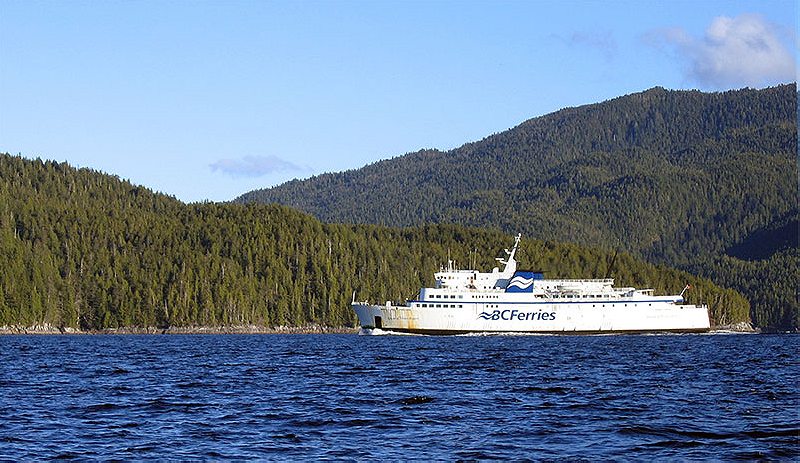
We departed for Haida Gwaii at night, anxious to stretch out and sleep after an uncomfortable drive that day. We joined crowds of travelers who avoided the $70 fee for a private room and instead laid down in the passenger lounge in neat rows on the floor, like kids on a field trip. Once away from the dock the northern winter night swallowed us whole. The boat’s engines and the chorus of snores were the only sounds we heard. Ferry carpet is thin, the lights are bright and the Hecate Strait, even on its best behavior, isn’t the type of water that lulls you to sleep. It was a long night, but soon enough the ferry was being roped to the creosote ties of the Haida Gwaii dock.
There’s nothing sweeter than arriving somewhere new by driving out of the mouth of a ferry; it feel like a scene in one of those military recruitment ads. Levi and I drove off the boat and away from the terminal feeling like anything was possible. We turned west towards Queen Charlotte City (population: 948) and when we emerged from the woods we saw the mountains of the Queen Charlotte Range for the first time. The mountains were bare of snow right to the top. The rocky peaks actually looked warm in the pink dawn light. Skiing did not seem possible.
We decided to visit the local forestry office. We bought a map and asked worker at the front desk questions about the local trails.
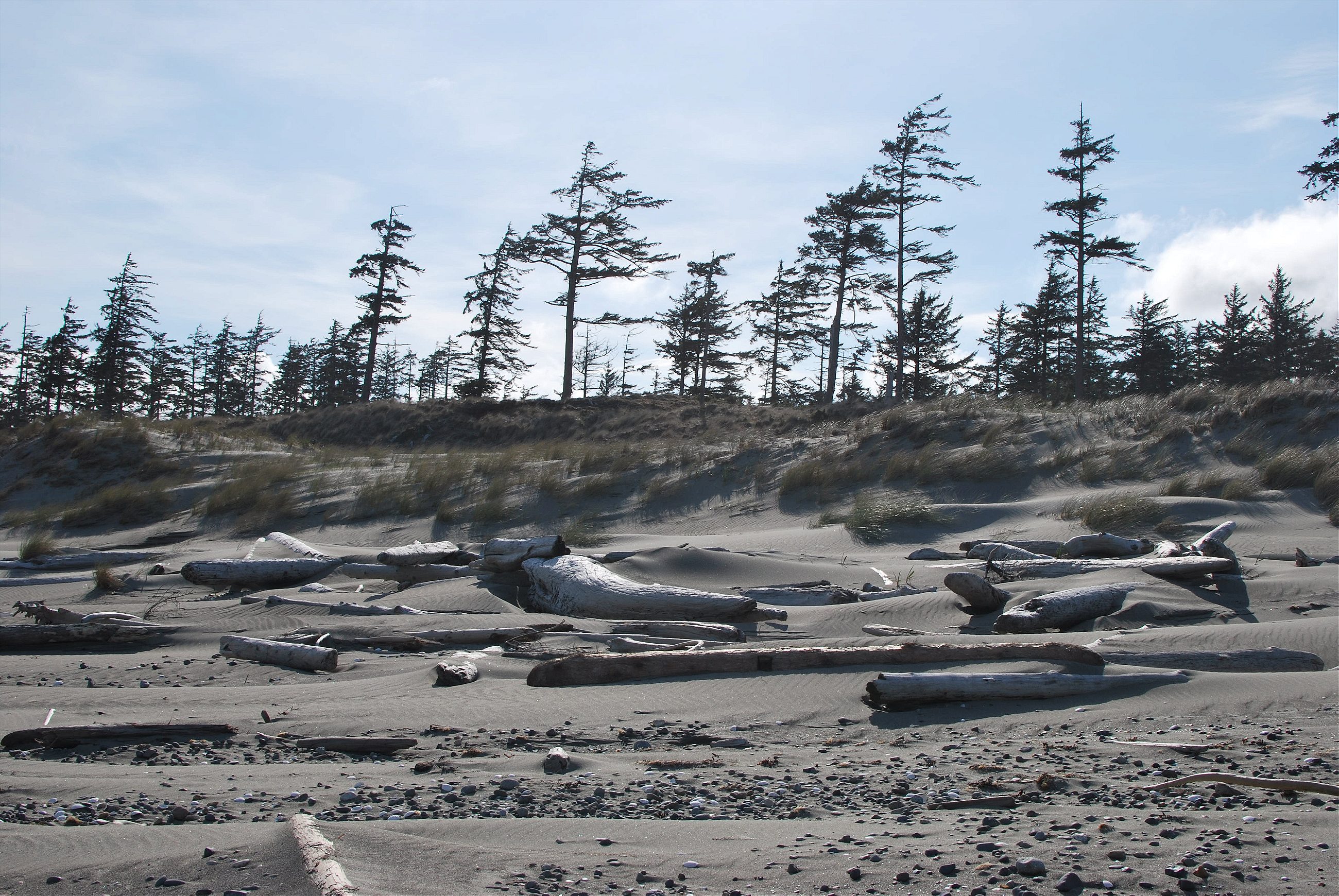
We didn’t mention skiing—it would be too embarrassing. Only an idiot would come to these islands trying to find snow during this non-winter. Instead, we talked about snow like it was something we didn’t want to run into, as if it were a grizzly bear or ticks.
“We won’t run into any snow up there, will we?” we asked each time the employee told us about a trail climbing one of the mountains.
The woman figured most mountains would be clear of snow, except for Mount Moresby, the islands’ tallest mountain at just over 3,800 feet. The mountain was a twenty-minute ferry ride away.
We took the small ferry across to Moresby Island and from the open car deck we could see the patches of snow hiding in the rocky trenches of Mount Moresby’s peak. Staring at this mountain for the first time was not some hunter-meets-prey moment; it was a moment where somebody canoeing an unknown river sees the drop of a waterfall on the horizon. I’m not a hunter; mountains are not my prey.

The drive to Mount Moresby is along a muddy track pulverized by logging equipment, the last stretch of road before the trailhead is a mess of old roads. Some sections were so old and underused that years of storm-thrown debris had created a mushy moss bed that was like driving through Jell-O. The road ended at a crumbling bridge over a stream. Three ribbons were all that marked it as the beginning of the trail.
We took a quick look at the trail and decided we would tackle it the next day. It was getting late and we had to catch the ferry to our base camp on the other island.
The next morning we were back on the trail, it followed an old logging road and after a few miles the brush across the road got so dense it looked like nobody had ever walked it. Mount Moresby was to our right and we were starting to curve around to its south aspect. We hadn’t seen that side but assumed it had less snow than the north aspect. We lost our nerve. Thinking we’d gone too far, we started bushwhacking along the base of the mountain. We traversed along a band of cliffs, looking for some sign of a trail. We found nothing and returned to the road, losing two hours in the process.
Our only option was to press through the thick brush on the road and see what was on the other side. There ended up being more trail behind the wall of dead trees, and with a running commentary that was a mix of relief and cursing, we continued our walk.
The faded trail ribbons were soon joined by a mass of new ribbons. Fresh spray paint ran down tree trunks, and placards with number combos were stuck to trees with nails still shiny from the hardware store. All of this area was due to be logged in the near future, the colour of the ribbons was a stark contrast to the mix of green and brown.
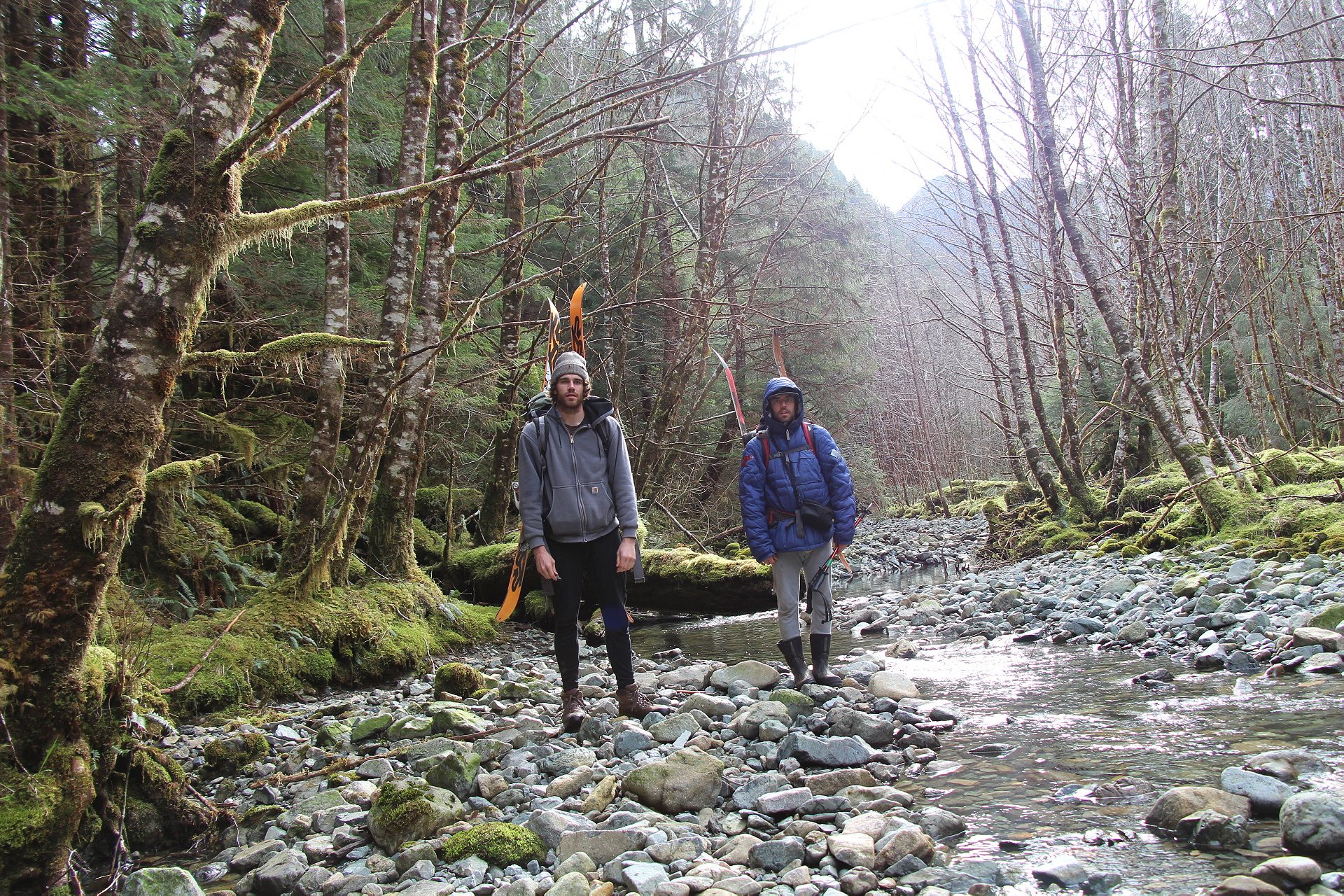
The road we were walking was the mossy remnants of what’s known in logging as a fore-and-aft road—a railway-style road built out of wood for early log trucks. To access these cut blocks, this old fore-and-aft road would also need to be reopened, and its reconstruction will bury this exhibit of old logging methods.
We pushed past the past and future logging blocks and around the backside of Mount Moresby. The road turned steeper and Levi started slowing down. He hated to bring it up, but he’d been sick for the last two days. I looked back through the bush to see him leaning against a tree, his oversized wool shirt rising and falling as he wheezed. This wasn’t just a case of the sniffles: Levi is a veteran tree planter, one of the toughest jobs in North America. When somebody with this background is coughing up blood and telling you his skin hurts, it’s for real. He rested while I explored farther.
I found the trailhead a few hundred feet from where we parted. Again, it was just a few rain-bleached ribbons hanging from the trees. I started climbing as fast as I could, knowing our window to make the evening ferry was closing. I used all four limbs, churning through the loamy ground up the side of the mountain. I climbed until I was sweating through my shirt and was rid of all doubt that this was our route.
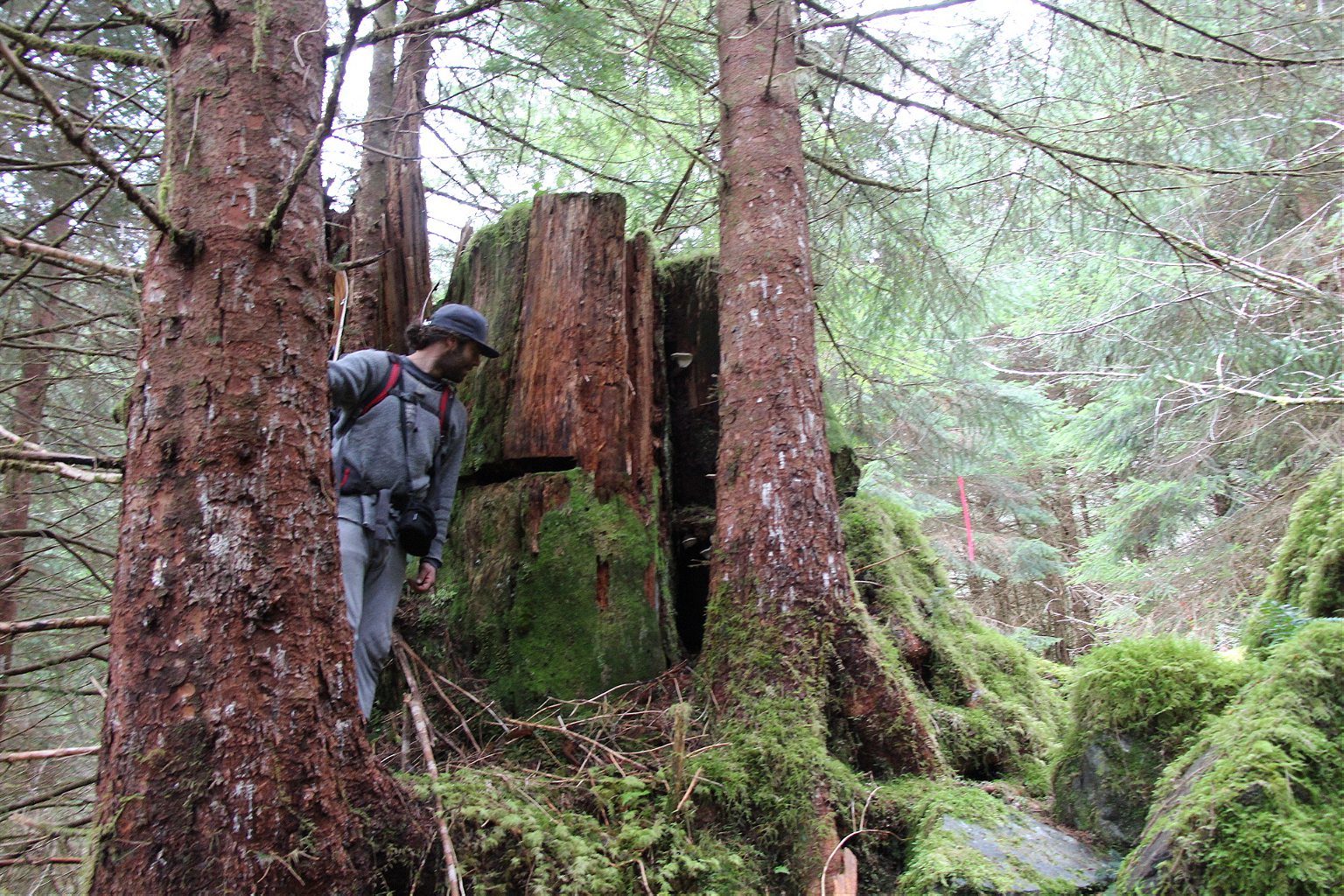
We now had a chance, but we’d lost our first day and the weather was supposed to turn into regular Haida Gwaii weather—wet and windy.
We drove back losers that night and were tempted by the availability of surfboards and good surf the next day. Surfing was a side mission we’d planned for this trip and it was more attractive than the thought of wading through a rain drenched forest up the side of a mountain for five turns in rotten snow.
But in the morning our sense of pride, coupled with a growing, irrational attachment to the mission had us on the first ferry to Mount Moresby. From the boat we could no longer see the mountain, only gathering clouds—the opening act for heavy rainfall in coastal B.C. Levi was feeling better, though, and we knew about half the trail now. There was still a chance.
Part way up the mountain it started getting wet. Not raining, just misty. Consecutive days of sunshine, especially in March, are as rare as a lunar eclipse in this part of the world. The moisture weighed down our already heavy bags; the steep and soggy trail crossed fresh rockslides and fallen trees with trunks the size of commercial jets. Our cotton clothing was heavy with moisture. We climbed higher, the fog got denser, we got wetter, the snow was still nowhere.

By the time we reached alpine and a break in the steepness Levi had gained a few hundred feet on me. It was past 1:00 p.m. and half our daylight was gone. The space between the two of us allowed me to think about a way to tell Levi we were running out of time. Another hour or so and we wouldn’t make it to the truck before dark. Our flashlight, now visible through the soaking wet top of my bag, had corroded battery terminals and only sort of worked some of the time. This wouldn’t be easy to say, not just because I wanted to find the snow as bad as he did, but also because at 33 years old, Levi is four years older than me. I’ve always been the younger cousin, the tag-along, the worrier.
I was behind a rock outcrop when Levi called me through the fog.
“Hey man, check this out.”
Not wanting to get too excited, I didn’t respond right away. I came out from behind the rock and above us, barely visible through the grey mist, were two patches of snow, one the size of a go-cart, the other the size of a sedan.
“There’s snow there!” I yelled, in slobbering happiness.
I bounded up to him, he was standing next to a puddle covered with a thin sheet of ice; our first contact with the effects of sub-zero temperatures. I picked up the China-plate of ice, and smashed it over my head in celebration.
To our right, Levi pointed to what looked like a potentially bigger snowfield, just visible past the rocky crevasses that made up the shoulder of Mount Moresby. Running low on time, we scurried across the rocks.
But we stopped short of the snowfield, sidetracked by a discovery that would have been more profound if we’d had the time to let it sink in. Leaning on a boulder, in the middle of that deserted mountaintop, was a single downhill ski. It was about thirty years old, the edges were rusting, and years of exposure had its layered construction peeling apart. Who had skied this mountain so long ago? Why had they abandoned their gear here?
We reached our snow patch, about as long as a bowling lane and only slightly wider. We strapped on our gear, did a couple runs, laughed about it, and managed one triumphant photo.
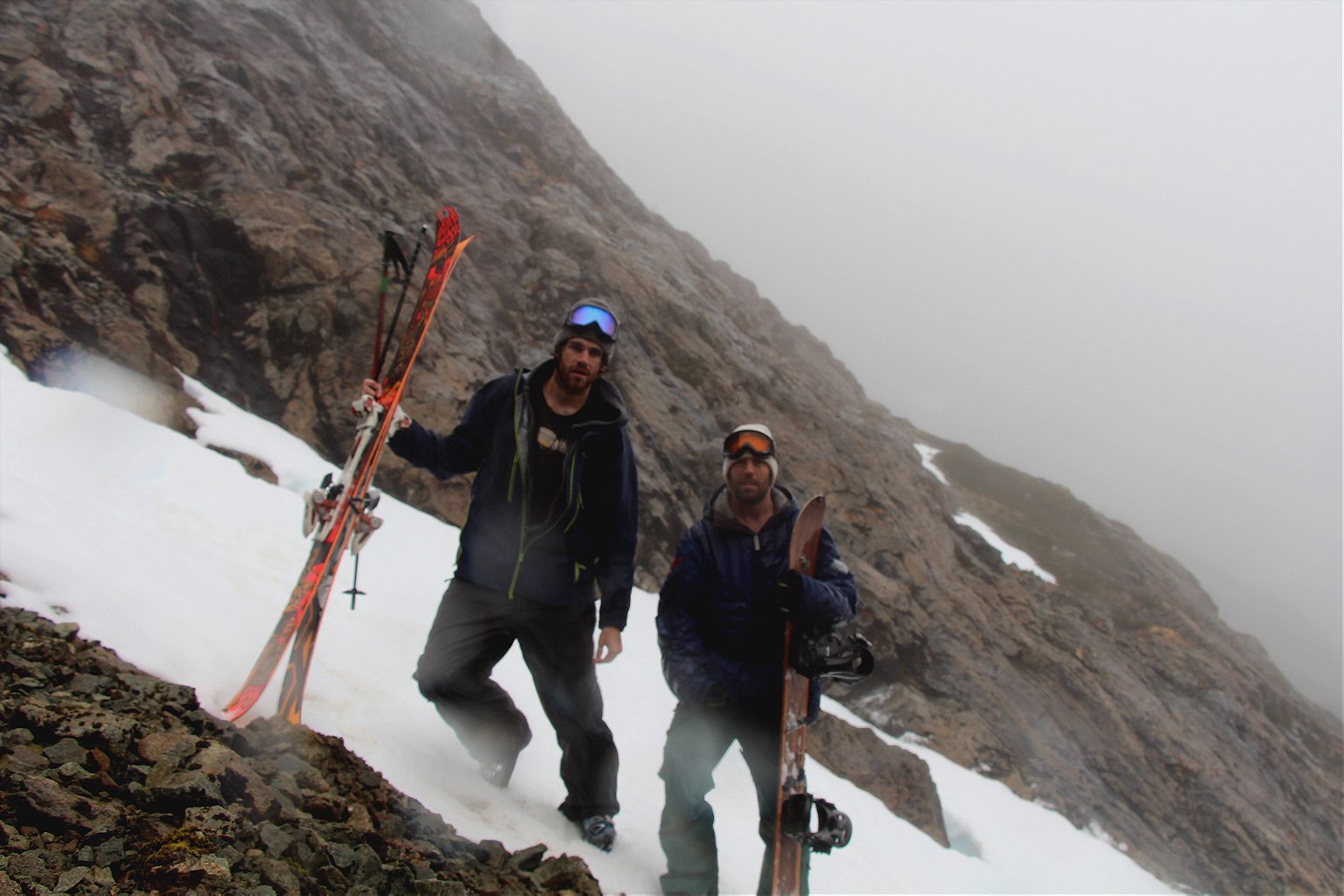
We’d skied Haida Gwaii—sort of. This was the ideal finish to our five-day, 1,200 mile, misadventure. A journey that, as soon as we saw the islands’ snowless peaks, became more about stubbornness, pride, and masochism than my previous vision of Levi and I being the only two powder skiers on a mythic island in the north Pacific.
We packed our gear and headed down the mountain, now saturated enough for most of our footholds to crumble with each step down. The walk down took as long as the walk up. Darkness soon fell and we arrived at the truck with the rigidity and poise of two leaking waterbeds.
We stayed that night in a hotel in Sandspit, the lone community on Moresby Island. We ate hamburgers and watched cartoons. Our appetite destroyed any misgivings about the wilted appearance of our food. Watching TV never felt so good.
The next night we were back on the ferry. The weather had cleared again and a full moon was rising as we left Haida Gwaii. I could see the outline of Mount Moresby from the deck of the ship. It was still unseasonably warm and after the rain the little patches of snow looked more meager than ever. We probably got the best run of the season yesterday.